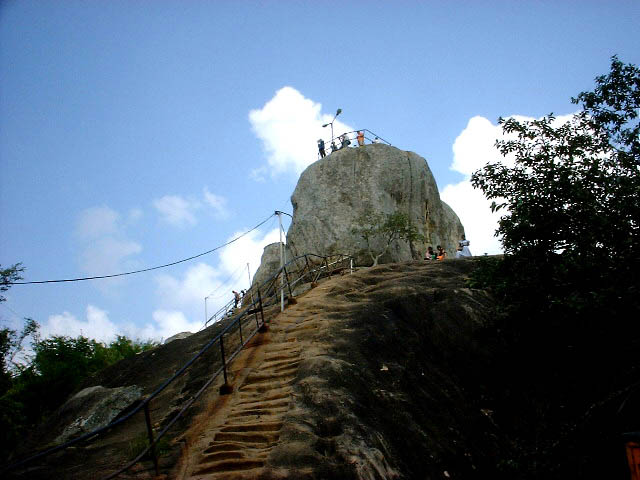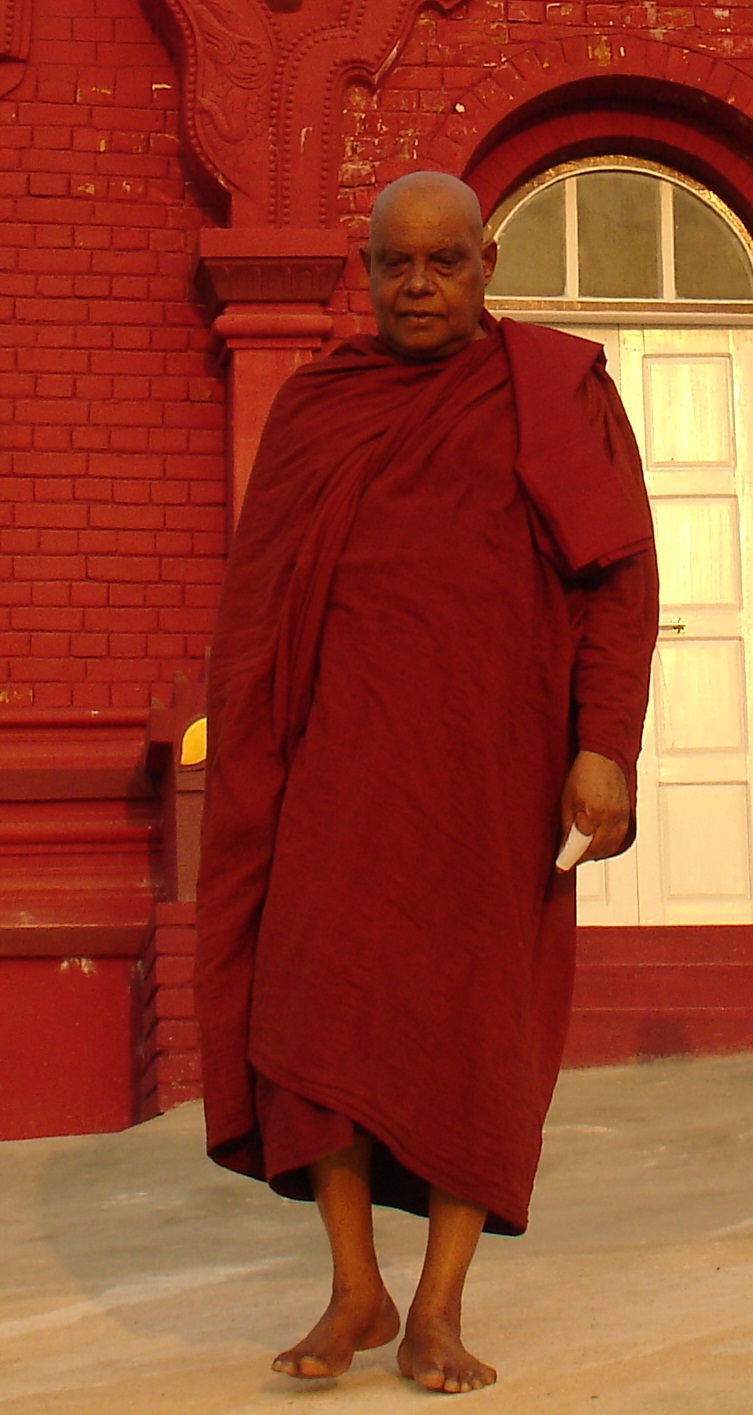Historical background

Establishment of Buddhism in Sri Lanka
After the era of the Ashoka, Indian Emperor Asoka, India lost her place as the Theravada Buddhist center of the world. It is said that emperor Asoka and his advisor monks predicted this would happen and organized a Theravada Buddhist Mission to nine countries in Asia. As a result of this mission, the great arahant Mahinda (Buddhist monk), Mahinda who was the son of emperor Asoka was sent to Sri Lanka in order to establish Buddha Sasana (message of the Gautama Buddha, Lord Buddha) with a group consisting of six Arhat, arahants called Ittiya, Uttiya, Sambala, Bhaddasala, Novice Sumana (Sumana Samanera) and Anāgāmi, anagami layman Bhanduka (Bhanduka Upasaka). The Devanampiya Tissa of Anuradhapura, King Devanampiya Tissa who was the king of Sri Lanka at that period met this group and accepted Buddhism and declared Buddhism as the state religion of Sri Lanka. The vice king Arittha who was the cousin of King Devanampiya Tissa was the first Buddhist monk of Sri Lanka who was called as arahant Upatissa. One year Later the emperor Asoka decided to send another group to Sri Lanka in order to establish a Buddhist Nuns' order (Bhikkhuni order) in Sri Lanka. The leader of this group was the daughter of the emperor Asoka who was the great arahant nun Sanghamitta, Sanghmitta. In addition, eighteen groups of technical people which were dedicated for Buddhist cultural works were sent with arahant Sanghamitta in order to strengthen the established Buddhist Lineage in Sri Lanka.History of Theravada Lineages
Since the first days of the establishment of a Theravada Buddhist Lineage in Sri Lanka, it has remained the main tradition there. After the era of the great Indian emperor Asoka, Sri Lanka was the global epicenter of the Theravada tradition. The Pāli Canon, Pali Canon (Theravada Tripiṭaka, Tripitaka), which was preserved and conveyed by memorization and recitation, was first written in Sri Lanka at the Aluvihare Rock Temple, Aluvihara in Matale. Almost all the early commentaries of Dhamma (Atthakatha, Attha Katha) were written in Sri Lanka. The popular commentary writer Bhiikku Buddhaghoṣa, Buddhaghosa was able to translate Sri Lankan commentaries which had been written in Sinhalese language, Sinhala Language into the Pali, Pali Language during the Anuradhapura Kingdom, Anuradhapura era. When other Theravada countries such as Thailand, Siam (Thailand) and Ramannadesa, Ramanna (Part of Burma/Myanmar) lost their monastic lineage, Sri Lankan monks were sent to re-establish the Upasampada monks' lineage during the period of the Kingdom of Polonnaruwa, Polonnaruwa Kingdom in Sri Lanka. Later, in the 17th century CE, the Upasampada Lineage had disappeared in Sri Lanka due to attacks and the subsequent domination of Western intruders. A novice monk, Weliwita Sri Saranankara Thero, Weliwita Saranamkara, brought Upasampada from Siam (Thailand) and was able to reestablish the lineage in Sri Lanka. During the 18th century several monks were able to again bring new Upasampada lineages from Amarapura (a part of Burma/Myanmar) and Ramannadesa, Ramanna (a part of Burma/Myanmar). Today three main Nikāya, Theravada Nikayas (Lineages) such as Siam Nikaya, Siam Niakaya, Amarapura Nikaya, Ramanna Nikaya are dominant in Sri Lanka: Siyam Nikaya is the lineage from Siam, Amarapura Nikaya is the lineage from Amarapura and the Ramanna Nikaya is the lineage from Ramanna.Forest Traditions
Forest monks and monasteries
In the early days, the forest traditions were affiliated either with the Great Monastery Anuradhapura Maha Viharaya, Mahavihara in Anuradhapura or with other main ancient monasteries such as Mihintale, Ritigala, Dimbulagala Raja Maha Vihara, Dimbulagala, Sithulpawwa Rajamaha Viharaya, Situlpawwa. Many ruins and caves of ancient forest monasteries can be seen in the large forest areas of Anuradhapura, Polonnaruwa, Matale, Tissamaharama, Sithulpawwa Rajamaha Viharaya, Situlpawwa and Principality of Ruhuna, Ruhuna and all over the island. Sri Lanka was then the center of Theravada, Theravada Buddhism as well as the Theravada forest tradition in the world. Many stories about ancient forest monks are recorded in the Pali Atthakatha, Atthakata and Visuddhimagga. Currently the largest forest sect in Sri Lanka is the Sri Kalyani Yogasrama Samstha, Sri Kalyani Yogashrama Samstha (Galduva Sect) of Rāmañña Nikāya of Amarapura–Rāmañña Nikāya. In addition, several other sects such as Vaturuvila, Polgasduva continue to have several forest monasteries.Preserving Pure Upasampada
The validity of Upasampadā, upasampada (high-ordination) of the monks is considered to be weaken if the monks become less respecting towards the Vinaya (monastic discipline) and Vinaya-kammas (disciplinary procedures) in Buddhist monkhood. The ordination is considered to be invalid, if the upasampada-kamma (high-ordination procedure) was not done properly according to the texts. Ancient forest monks were considered to be well aware of this and have been protecting the validity of Upasampadā, upasampada in the main three Theravada countries up until the period of Amarapura forest monks in Burma. During the 19th century, two groups of Sri Lankan monks were considered to be borrowed the trustworthy-upasampada from Amarapura forest monks in Burma, and established the Amarapura–Rāmañña Nikāya, Amarapura and Rāmañña Nikāya, Ramanna Nikayas of Sri Lanka. When these two Nikayas were considered slowly becoming lax in higher Vinaya, Sri Kalyani Yogasrama Samstha was established by a group of Rāmañña Nikāya, Ramanna Nikaya monks lead by Kadawedduwe Jinavamsa Mahathera, Kadawedduwe Jinavamsa Maha Thera, in order to preserve the forest Vinaya lineage further.Notable contemporary monks
Ambagahawatte Indrasabhawara Gnanasami Maha Thera
Founder of Rāmañña Nikāya, Sri Lanka Ramanna Maha Nikaya in 1864 by bringing pure Upasampadā, Upasampada from Ratnapunna Vihara in Burma and joining with group of monks who brought pure Upasampadā, Upasampada from Kalyani Ordination hall, Sima in Burma and from Dhammayut Nikaya in Thailand. His intention was to re-establish a pure Vinaya lineage in Sri Lanka.Puwakdandawe Paññānanda Maha Thera
Brought pure Upasampada from Kalyani Ordination hall, Sima of Burma and joined with the Ambagahawatte Indrasabhawara Gnanasami Maha Thera in order to establish Rāmañña Nikāya, Sri Lanka Ramanna Maha Nikaya. He was considered the pioneer of forest dwellers in Rāmañña Nikāya, Sri Lanka Ramanna Maha Nikaya. Some of his lineage's successor monks joined Sri Kalyani Yogasrama Samstha and some of them remain in Delduva sect of Rāmañña Nikāya, Sri Lanka Ramanna Maha Nikaya.Vaturuvila Gnanananda MahaThera
Founder monk of Vaturuvila Vanavasa sect of Siyam Nikaya.Kadawedduwe Jinavamsa Mahathera, Kadawedduwe Jinavamsa Maha Thera
Being the founder of Sri Kalyani Yogasrama Samstha in 1951 as a reform movement during the Sambuddhatva jayanthi, Buddha Jayanti (B.E. 2500) festival years, his intention has been to protect the pure Vinaya lineage in Sri Lanka.
Matara Sri Nanarama Mahathera, Matara Sri Nanarama Maha Thera
Matara Sri Nanarama Mahathera who is considered to be the father of the Sri Lankan modern forest meditation tradition, was a researcher of old Sri Lankan vipassana meditation methods and have been influenced by Burmese Mahasi Sayadaw, Mahasi Vipassana Method. Nauyane Ariyadhamma Maha Thera, Hikkaduve Dhammasila Mahathera, Migoda Sanghsobhana Maha Thera and Greek Nyanadassana Maha Thera are several of his close students.Matale Silarakkhita Maha Thera
The founder of Ruwangirikanda forest monastery who later joined with Sri Kalyani Yogasrama Samstha. Natagane forest monastery and Budugallena forest monastery were re-established under Silarakkhita Maha Thera.Madawala Dhammatilaka Maha Thera
The first abbot of Nimalawa forest monastery after joining with Sri Kalyani Yogasrama Samstha.Nauyane Ariyadhamma Mahathera, Nauyane Ariyadhamma Maha Thera
A student of late venerable Kadawedduwe Jinavamsa Mahathera, Kadawedduwe Jinavamsa Maha Thera who was believed to be a having exceptional memory and restraint.Welimada Dhammadassi Maha Thera
A student of Kadawedduwe Jinavamsa Mahathera, Kadawedduwe Jinavamsa Maha Thera and Matara Sri Nanarama Mahathera, Matara Sri Nanarama Maha Thera who is the current abbot of the Nimalawa forest monastery.Hikkaduve Dhammasila Maha Thera
A student of Kadawedduwe Jinavamsa Mahathera, Kadawedduwe Jinavamsa Maha Thera and Matara Sri Nanarama Mahathera, Matara Sri Nanarama Maha Thera who compiled the Vinaya manual of Sri Kalyani Yogasrama Samstha and is the current abbot of the Beralihela Forest Monastery.Foreign monks
* GreeNyanadassana
Maha Thera
Contemporary forest monasteries
 Some of the widely known forest monasteries, among the large number of monasteries scattered throughout the island are listed below.
Some of the widely known forest monasteries, among the large number of monasteries scattered throughout the island are listed below.
Nimalawa Forest Monastery
One of the ancient forest monasteries where the arahant Dhammadinna was considered to be resided. It was re-established as the first forest monastery of Sri Kalyani Yogasrama Samstha in 1951 by Kadawedduwe Jinavamsa Mahathera, Kadawedduwe Jinavamsa Maha Thera.Na Uyana Forest Monastery
Na Uyana Aranya is situated in the North Western Province and affiliated to Sri Kalyani Yogasrama Samstha and Pa-Auk Forest Monastery in Myanmar.Tanjantenna Forest and Monastery
Kudumbigala Forest Monastery
An ancient monastery in Kumana forest sanctuary which is famous for its isolated environment and beautiful landscapes which was re-established by late Thambugala Anandasiri Mahathera.International Institute of Theravada - IIT Forest Monastery
Newly established monk-training monastery at Karuwalagaswewa Divisional Secretariat, Karuwalagaswewa, bordering the forest sanctuary of Wilpattu National Park. Affiliated to Sri Kalyani Yogasrama Samstha.References
External links
Buddhist Forest Monasteries and Meditation Centers in Sri Lanka
{{Buddhism in Sri Lanka Theravada Buddhism in Sri Lanka